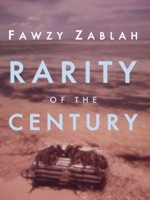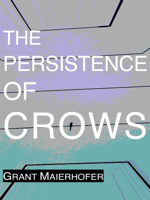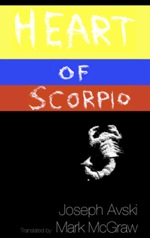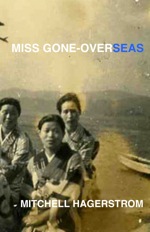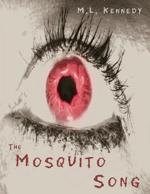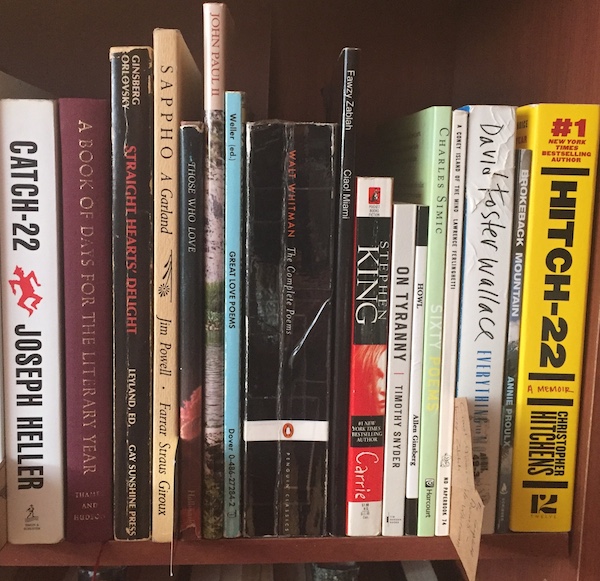
TEXT / MUSIC / IMAGE: Review of dom’s 2017
dom’s Lists (first Categorical, then Chronological)
of the Art-Works he Consumed thru/o 2017:
TEXT
The books and stories I read thru/o 2017.
- Catch-22 (1961, novel) – Joseph Heller (began Nov. 2016; finished March 2017)
- A Book of Days for the Literary Year (1984, anthology of literary trivia) – ed. Neal T. Jones, publisher: Thames and Hudson Inc. (began Jan. 1, 2017)
- “The Nose” (1836, short story) – Nikolai Gogol
- Straight Hearts’ Delight: Love Poems and Selected Letters 1947-1980 (1980, anthology of poetry & letters written by & between the infamously gay, Beat-writer couple) – Allen Ginsberg & Peter Orlovsky
- Sappho: A Garland (1993, poetry translation) – Sappho, trans. Jim Powell
- Think of Me Kindly (19??, poetically structured passages from his written letters) – Ludwig van Beethoven
- Those Who Love (1969, Hallmark-selected collection of her poems) – Sara Teasdale
- The Poetry of John Paul II: Roman Triptych: Meditations (2003, poetry collection) – Pope John Paul II
- Best Love Poems (1992, poetry anthology) – ed. Shane Weller
- The Complete Poems (2004, poetry collection academically anthologized) – Walt Whitman (began Apr. 21, 2017)
- Ciao! Miami (2006, short story collection) – Fawzy Zablah (began May 16, 2017)
- Carrie (1974, novel) – Stephen King
- On Tyranny: Twenty Lessons from the Twentieth Century (2017, nonfiction political philosophy) – Timothy Snyder
- Howl and Other Poems (1956, poetry collection) – Allen Ginsberg
- “A Tale of the Ragged Mountain” (1844, short story) – Edgar Allan Poe
- Sixty Poems (2008, poetry collection) – Charles Simic
- A Coney Island of the Mind (1958, poetry collection) – Lawrence Ferlinghetti
- Ciao! Miami (2006, short story collection) – Fawzy Zablah (finished Oct. 27, 2017)
- The Complete Poems (2004, poetry collection academically anthologized) – Walt Whitman (finished Nov. 15, 2017)
- “The Assignation” (1834, short story) – Edgar Allan Poe
- Everything and More: A Compact History of Infinity (2003, nonfiction mathematical history & theory) – David Foster Wallace
- Brokeback Mountain (1998, novella published as stand-alone book) – Annie Proulx
- Hitch-22 (2010, memoir) – Christopher Hitchens
- A Book of Days for the Literary Year (1984, anthology of literary trivia) – ed. Neal T. Jones, publisher: Thames and Hudson Inc. (finished Dec 31, 2017)
MUSIC
The albums and songs/singles I listened to all the way through for the first time thru/o 2017.
- “Goose Snow Cone” (2017, folk rock song/single) – Aimee Mann
- Mental Illness (2017, folk rock album) – Aimee Mann
- “Shape of You” (2017, dance pop song/single) – Ed Sheeran
- “Castle on the Hill” (2017, pop rock song/single) – Ed Sheeran
- “Feel It Still” (2017, alternative rock song/single) – Portugal. The Man
- orphans (2017, ambient electronic ep) – AFX (Aphex Twin)
- Painted Ruins (2017, art rock album) – Grizzly Bear
- “Dear Life” (2017, pop-rock song/single) – Beck
- Music Has the Right to Children (1998, ambient electronic album) – Boards of Canada
- Mountain Moves (2017, indie rock album) – Deerhoof
- “The Gate” (2017, folk electronic song/single) – Björk
- Colors (2017, experimental pop-rock album) – Beck
- MASSEDUCTION (2017, electronic art pop-rock album) – St. Vincent
- “Wallowa Lake Monster” (2017, electronic art rock song/single) – Sufjan Stevens
- “Look at Your Hands” (2017, indie folktronic song) – Tune-Yards
- “Blissing Me” (2017, art pop ballad) – Björk
- Utopia (2017, avant-garde folktronic rock album) – Björk
- The Tourist (2017, indie rock album) – Clap Your Hands Say Yeah
IMAGE
The films and television shows/series I (re-)watched (& remembered viewing) thru/o 2017.
- Mulholland Dr. (2001, dramatic surreal film) – writer/dir. David Lynch; starring: Naomi Watts, Laura Elena Harring, and Justin Theroux
- Twin Peaks, Seasons 1 & 2 (1990 & 1990-1, art television series) – creators: David Lynch & Mark Frost; starring Kyle MacLachlan and Various
- Twin Peaks: Fire Walk with Me (1992, dramatic surreal film [a tie-in to the series]) – writer/dir. David Lynch; starring: Sheryl Lee
- Twin Peaks: The Return (2017, televised surreal film) – creators: David Lynch and Mark Frost; dir. David Lynch; starring: Kyle MacLachlan and Various
- Schitt’s Creek, Seasons 1 & 2 (2015 & 2016, comedic television series) – creators: Dan and Eugene Levy; starring: Dan Levy, Eugene Levy, Catherine O’Hara, & Annie Murphy
- Boogie Nights (1997, dramatic film) – writer/dir. Paul Thomas Anderson; starring: Mark Wahlberg, Julianne Moore, Burt Reynolds, William H. Macy, John C. Reilly, Don Cheadle, Heather Graham, & Philip Seymour Hoffman
- Magnolia (1999, dramatic film) – writer/dir. Paul Thomas Anderson; starring: Tom Cruise, Julianne Moore, Philip Seymour Hoffman, William H. Macy, John C. Reilly, Melora Walters, & Philip Baker Hall
- America’s Got Talent, Season 12 (2017, reality contest television series) – creator/prod. Simon Cowell
- Death Becomes Her (1992, comedic film) – writers: Martin Donovan & David Koepp; dir. Robert Zemeckis; starring: Goldie Hawn, Bruce Willis, Meryl Streep, & Isabella Rossellini
- No Cure for Cancer (1993, stand-up comedy film) – Denis Leary
- The Jinx: The Life and Deaths of Robert Durst (2015, documentary miniseries) – writer/dir. Andrew Jarecki; additional writers: Marc Smerling & Zachary Stuart-Pontier
- 13th (2016, political documentary film) – writer/dir. Ava DuVernay; additional writer: Spencer Averick
- Shivers (1975, body horror film) – writer/dir. David Cronenberg
- Tucker and Dale vs. Evil (2010, comedy horror film) – writer/dir. Eli Craig; additional writer: Morgan Jurgenson
- The ABCs of Death (2012, anthology comedy/horror film) – prod. Ant Timpson & Tim League; writers/dir. Various
- Stranger Things (2016, sci-fi horror miniseries) – creators/writers/dir. The Duffer Brothers (Matt and Ross)
- Stranger Things 2 (2017, sci-fi horror miniseries) – creators/writers/dir. The Duffer Brothers (Matt and Ross)
- The Babysitter (2017, horror/comedy film) – dir./prod. McG (Joseph McGinty Nichol); writer: Brian Duffield
- Rick and Morty, Seasons 1 & 2 (2013 & 2015, animated television series) – creators/prod. Justin Roiland & Dan Harmon; additionally, voice actor: Justin Roiland
- Black Mirror, Seasons 1, 2, “Special,” & 3 (2011, 2013, 2014, & 2016, sci-fi/horror anthology television series) – creator/prod./primary writer: Charlie Brooker
- Family Guy, Season 16 (2017, animated comedy television series) – creator/voice actor: Seth MacFarlane [particularly noteworthy: Ep. 6, “The D in Apartment 23”]
- Bob’s Burgers, Season 8 (2017, animated comedy television series) – creator/prod. Loren Bouchard; writers/dir. Various
- Murder on the Orient Express (2017, adapted murder mystery film) – screenplay: Michael Green; dir. Kenneth Branagh; starring: Kenneth Branagh, Penelope Cruz, Willem Dafoe, Judi Dench, & Johnny Depp
- Gabriel Iglesias: I’m Sorry For What I Said While I Was Hungry (2016, stand-up comedy film) – Gabriel Iglesias
- Schitt’s Creek, Season 3 (2017, comedic television series) – creators/actors: Dan and Eugene Levy; starring: Dan Levy, Eugene Levy, Catherine O’Hara, & Annie Murphy
- Best in Show (2000, mocumentary film) – writer/dir. Christopher Guest; writer: Eugene Levy; starring Jennifer Coolidge, Christopher Guest, & Eugene Levy
- Punch-Drunk Love (2003) – writer/dir. Paul Thomas Anderson; starring: Adam Sandler, Emily Watson, & Philip Seymour Hoffman
- Seuss’ How the Grinch Stole Christmas (2000, adapted live-action comedy film) – screenplay: Jeffery Price & Peter S. Seaman; dir. Ron Howard; starring: Jim Carrey
- The Nightmare Before Christmas (1993, animated dark fantasy musical film) – creator/prod. Tim Burton; writers: Michael McDowell & Caroline Thompson; dir. Henry Selick; voice actors: Chris Sarandon, Danny Elfman, Catherine O’Hara, & Ken Page
- Mixed Nuts (1994, Christmas comedy film) – writer/dir. Nora Ephron; writer: Delia Ephron; prod. Joseph Hartwick, Paul Junger Witt, & Tony Thomas; starring: Steve Martin
- National Lampoon’s Christmas Vacation (1989, Christmas comedy film) – writer/prod. John Hughes; dir. Jeremiah S. Chechik; starring: Chevy Chase & Beverly D’Angelo
- A Christmas Story (1983, Christmas comedy film) – writer/prod./dir. Bob Clark; additional writers: Jean Shepherd & Leigh Brown; additional prod. Rene Dupont
- Phantom Thread (2017, bittersweet-romance fairy tale film) – writer/dir. Paul Thomas Anderson; starring: Daniel Day-Lewis, Lesley Manville, & Vicky Krieps
- Black Mirror, Season 4, Episode 1 “USS Callister” (2017, sci-fi anthology television series) – writers: Charlie Brooker & William Bridges; dir. Toby Haynes; starring: Jesse Plemons, Cristin Milioti, & Jimmi Simpson
Top Favorites, with Blubs, from Each Category
TEXT: Top 7
- Hitch-22 (2010) – Christopher Hitchens
- Perhaps the book which stood out to me the most (possibly in no small part due to having just finished it) was Christopher Hitchens’ memoir, Hitch-22, an obvious and accurately-made allusion to Joseph Heller’s Catch-22. Hitchens was and remains one of my personal intellectual/authorly heroes and, though I couldn’t ‘get into’ the dense thickness of his memoir when I bought it a few months after graduating in 2011, I now found Hitchens’ writing style, his voice, and his artistic knack for deftly analyzing his life and dividing it into exquisitely self-contained essays to be delicious, nutritious, and magnificent. Throughout his memoir, Hitchens often says that it is important (certainly for him and for others who wish to think for themselves) to “keep two sets of books,” primarily meaning one must develop, practice, and employ the necessary skills of seeing issues from both sides and attacking bad ideas in all forms from every side that can effectively attack it from a stance of reason and justice. A natural consequence of living a life like this is to practice and put into practice the skill of being vociferous on the given issue, regardless of what others may think or of what the group-at-large thinks by prescription. I was also amazed that, many of the issues or events Hitchens participated in or witnessed are, it seems, repeating: in his youth, Hitchens traveled and reported upon totalitarian, far-right politics around the world and learned from experience that the best course of action is to, not limit speech, but to increase speech’s freedom thereby learning what your opponent (whether a Nazi, a totalitarian leader, or a professor participating in a debate) thinks and, more importantly, how your opponent thinks. Of course, I cannot do justice to Hitchens’ words, but Hitch-22 is an essential read for anyone who has a mind for thought, for literature, for philosophy, for activism, for truth and justice, and for anyone who desires to explore the unique world of Christopher Hitchens’ life through his beautifully written memoir.
- Everything and More: A Compact History of Infinity (2003) – David Foster Wallace
- Another literary hero of mine, I have made it a goal of mine to read every book by David Foster Wallace in chronological order of publication, at least one book a year, and 2017 nearly came to an end before I realized I hadn’t read the next book by Wallace in my nerdly goal, Everything and More: A Compact History of Infinity. I dutifully picked up this complex little “booklet” on the concept, history, and mathematical implications of Infinity and began to read. It’s a good thing I did, too, because the complexity of Wallace’s writing helped prepare me mentally, I believe, for the delicious challenge and rich reward of reading Hitch-22. One wonders, therefore, if David Foster Wallace knew of or had ever read Christopher Hitchens, and whether Hitchens knew of or had ever read Wallace. Did these two contemporaries, each having books published to a fair amount of mainstream awareness (c. 1996-2007/8)—these Mental Giants, each occupying his own writerly sphere—did they ever come into contact or read each other’s work? All of the evidence I have witnessed implies not, but of course, this kind of “what if” game can go on indefinitely, which could, if played too often, hinder everyday life. An example of a similarly unending mind-game serves as Wallace’s introduction to the reader of the book’s style and pace. Wallace’s intriguing and thought-stretching little book seeks to discuss or at least briefly mention the seemingly unlimited growth of complexities which arise both out of the concept of infinity itself and out of its existence within mathematics-as-an-academic-discipline. If you venture to pick and ‘get into’ David Foster Wallace’s “booklet,” bring a notebook and a pen and prepare to do some enjoyable work in deciphering the insanity of Everything and More: A Compact History of Infinity.
- Ciao! Miami (2006) – Fawzy Zablah
- In the spring, I came up with the idea of trying my hand at reviewing again, starting with my literary friend’s self-published debut collection of short stories. While I had intended for years to read and review Zablah’s inspiring and well-crafted collection of stories, I finally settled down to do it; little did I know that, about a month later, I would then be forced to embark on the journey of searching for and procuring a new apartment to share with my boyfriend, as well as then to move out of our respective places and move into the new apartment, as well as then to settle within our new home. It therefore took me several months more than expected to finish taking notes on the book and to write my review of it and to have it posted to this same blog. Nevertheless, I am rather proud of my review, and I am humbled to be able to call the gifted storyteller and character-crafter Fawzy Zablah an inspiring friend. Picking up a copy of this book will inspire and entertain, and may even provoke a bit of thought within the reader, which is just what is desired from budding literary talent. If you’d like to learn more about Fawzy Zablah’s Ciao! Miami, you can read my review of the book here.
- The Complete Poems (c. 1855-92; ed. 2004) – Walt Whitman
- I have read Walt Whitman’s Leaves of Grass before, both the first (1855) and last (1891/2) editions (in opposite order), as well as Whitman’s American Civil War poetry and prose, and his debut novel, Franklin Evans; or The Inebriate. At the height of this past Spring, perhaps while the lilacs were blooming, I recalled Whitman’s advice to read his book in every season and so, since he is one of my all-time favorite poets, I decided to do just that. This time, I picked up an edition from the Penguin Classics series called The Complete Poems (ed. Francis Murphy), which contains (as the title suggests) all of his poetry, including the final (1891/2) edition of Leaves of Grass, four prefaces and an afterward to various editions of Leaves of Grass, and nearly every other known (as of 2004) poem written by the infamously American poet, from early verse efforts to scribbles written during Whitman’s final days. My soul was warmed by the glowing rays of this brilliant tome, which I read and relished throughout most of the past year, from the Spring to the Autumn, and happily so.
- Straight Hearts’ Delight: Love Poems and Selected Letters 1947-1980 (1980) – Allen Ginsberg & Peter Orlovsky
- Yet another favorite poet of mine, I find, as I do with Walt Whitman, a kinship with Allen Ginsberg, who himself admired and was inspired by Whitman. So, having miraculously found/discovered this book in an independent, used-bookstore, I knew this was an artistic artifact both of the Beat-poet generation and of a long-term romantic relationship between a historical gay couple within a literary movement: Gen. Beat’s quintessential poet Allen Ginsberg and his lifelong partner Peter Orlovsky. Straight Hearts’ Delight, then, is an unparalleled chronology of two souls coming together, warts and all, and is comprised of queer-themed poetry and intimate letters, each having been written by both men either separately, together, or to each other from across the globe. When I began reading this remarkable book in March, I did so hoping to be inspired by the poets in order to craft a one-year anniversary gift for my boyfriend James. This would prove, I hoped, the love I had given over the past year and my devotion to continue giving love in the years to follow. I was therefore awed by the book’s portrayal of how love and devotion can function for a gay couple, both in public and in private; I also felt gracious and humbled to have been allowed a peek into the private innerworkings of the infamously queer author-couple. Particularly surprising and instructive was the candid way both Ginsberg and Orlovsky expressed their relationship’s ups and downs in their written works. I think this depressive-realistic theme throughout the book, more than the love and devotion presented therein, taught me to understand that there can be minor flaws present within a relationship and that the relationship can withstand these flaws: it need not succumb to failing in living up to ‘a fairy tale ending’. And a well-timed lesson, too, since this wisdom came to me at precisely the right moment, when a year-long commitment with and renewal to stay committed to my partner James was approaching and in need of fortification and support. With regard to this, Ginsberg’s and Orlovsky’s touchingly real Straight Hearts’ Delight was the exactly correct choice.
- On Tyranny: Twenty Lessons from the Twentieth Century (2017) – Timothy Snyder
- After the election of Donald Trump in early November, 2016, I felt, as so many did, bewildered, angry, adrift. I hadn’t felt the pang of Christopher Hitchens’ absence more acutely since reading his beautiful, masterful post-humous book Mortality in the Autumn of 2013. For help, I read Letter to a Young Contrarian, which was comforting and, ironically, made Hitchens’ absence all the more painful. Within a week of the election, whilst reading Letter to a Young Contrarian, I recalled Christopher’s young colleague and public thinker/intellectual, Sam Harris, who, it should go without saying, had a great deal to say about the election of Donald Trump. At any rate, I began obsessively listening to Harris’ podcasts while washing dishes and cleaning; one podcast early in June was with Timothy Snyder (who was, I later found out, mentioned in Christopher Hitchens’ memoir). Snyder was being interviewed/conversing with Sam Harris about the former’s newly published book, On Tyranny: Twenty Lessons from the Twentieth Century. Their conversation, both on the book and its relevant commentary regarding recent events, inspired me to seek out the book at Barnes & Noble, which I did and read that very day. Refreshingly, Snyder’s short, well-crafted book inspired within me a sense of purposeful action to counter all forms of encroaching totalitarianism within my everyday life. Insightful and nourishing, Timothy Snyder’s On Tyranny: Twenty Lessons for the Twentieth Century is essential reading for anyone who felt negatively affected by the 2016 election, who feels rightly outraged by Trump and his ilk, and who fears the rise of extreme political movements which attempt to claim supreme power over all.
- Brokeback Mountain (1997/8) – Annie Proulx
- I saw this film at the dollar theater in my hometown on a date with my then-boyfriend, and was utterly captured by the fateful tragedy of the main characters; I was, of course, reduced to tears. And yet, I had heretofore never read the story, which was first published in The New Yorker and later by author Annie Proulx in a collection of short stories. My edition is a tiny stand-alone tie-in book published independently from Proulx’s other stories. So, in looking for something to read quickly and enjoyably after the infinite insanity of Wallace’s Everything and More, I selected this tiny-book novella, having been purchased earlier this year at Chicago-based resale shop Brown Elephant. And this tiny, amazing story was the correct choice: Proulx’s writing style is as stark as the wilderness which brings together the story’s tragic gay lovers, Ennis del Mar and Jack Twist. Together, they form a relationship which provides the reader a glimpse into the mindsets and neuroses of Ennis and Jack, two gay lovers living in an unaccepting time and place. A short story/novella which couldn’t have been written any other way than as a Grecian Tragedy (and which is, therefore, all the more emotionally stirring), Annie Proulx’s Brokeback Mountain is sagely well-crafted, masterfully developed, and simply exquisite.
MUSIC: Top 6
- Utopia – Björk
- Björk is by far my favorite singer/songwriter/musician/musical artist, so it was inevitable that I would select her latest album, Utopia, as my number-one favorite album of 2017. Even so, I was unprepared by how deeply I would be moved by Björk’s Utopia, nor was I prepared by how deeply I would fall in love with it. I was, in fact, dubious both of the album’s title and of her choice to bring Arca further into her world as the album’s co-producer, but when it came down to it, I ought to have known better than to doubt my musical goddess. Utopia as a title seemed, at first, to be a too-obvious choice as a title, especially since Björk has coined some gorgeous words to serve as titles to albums and songs, as well as some ingenious terms that are uniquely-worded yet universally understood, thereby embodying the human condition within Björk’s skillful artistry. On Utopia, for example, there was a song titled “Paradisia,” which seems at first glance to be a better choice for such a turn-of-phrase artist; however, upon reflection, I believe the selection of “Utopia” to have been superior since, as Björk herself must know, evidenced by the fact that she referred to the title as “cliché” in an interview, one person’s vision of Utopia is another person’s version of hell. So Björk’s choice in title is an admission that she knows this is her version, or her attempt at a version, of what Utopia could look like or how it could function in its way so as to become Utopia, but that this might not be everyone’s way; as such, I forgave the title and embraced it as well-selected. As for the latter matter, I feared that Björk, both as an artist and an intelligent individual, was being too negatively influenced by the youthful whims of Arca and his unbridled beats. However, at that time, I knew virtually nothing of Arca beside his perfectly-followed execution of the beats he was directed to produce on Björk’s Vulnicura, so I was pleasantly surprised by Arca’s role as co-pilot producer on Utopia; though it was noticeably divergent from a truly Björkian objective, Arca’s deftly-employed beats were nonetheless complimentary to Utopia’s vision. It is a vision which upholds a major theme that Björk has said is present throughout this newest album: the necessity of people to come together, to collaborate, and to grow and develop and evolve as individuals working both toward and within a unified society. Yet aside from these newer elements, Björk’s moving latest is an exquisitely interwoven tapestry of music, sound, and lyrical engineering, of evolution, mysticism, and confessional truth. Björk’s deliciously complex album manages to numinously inspire and enticingly beckon the listener into Björk’s newest fantastical world. Triumphantly, Björk’s Utopia is akin to an entire masterpiece opera or symphony divided into parts and movements, which almost demands to be listened to as a complete whole instead of a mere collection of songs. Those who exert the mental and intellectual effort required to delve within Björk’s airy, birdsong-filled paradise will be duly rewarded by Utopia’s joyfully shapeshifting musical compositions. Though one person’s Utopia is another’s hell, at the heart of Björk’s version is the humane and redemptive themes of encouragement, love, hope, and the necessity of can-do, activist activity required to overtake hatred.
- Tracks: “Arisen My Senses,” “The Gate,” “Body Memory,” “Creatures Features,” “Losss,” & “Saint”
- MASSEDUCTION – St. Vincent
- If St. Vincent’s previous album, the self-titled fourth from this pop/rock artist, was a loud and self-asserting hit, then MASSEDUCTION is an intimate sequel answering the question: What happens when the artist acquires a lover? (This same theme, which is answered positively on Björk’s Utopia with friendship-love Arca, is answered negatively in Paul Thomas Anderson’s Phantom Thread.) As St. Vincent has said in interviews leading up to the release of her fifth album, there is so much of herself and her previous life on MASSEDUCTION, which include depictions of a deeply intense relationship, the cracks in it’s foundation, the eventual dissolution of the relationship, and the difficulty that exists for two friends to remain friends as one grows and the other does not. St. Vincent’s use of irony and deep-seated love-sickness in her lyrics and instrumentational choices is superb and masterful, from “In Los Ageless, the mothers milk their young” on “Los Ageless” to the punch-gut feeling of loss on “Slow Disco.” An emotionally draining album, St. Vincent’s MASSEDUCTION is as edgy and harrowing as it is satisfying and successful, being an album which, like Björk’s 2015 Vulnicura, chronicles the end of a relationship, a process which can soothe anyone who has suffered a broken heart.
- Tracks: “Hang On Me,” “Masseduction,” “Sugarboy,” “Happy Birthday, Johnny,” & “Dancing With a Ghost”/“Slow Disco”
- Painted Ruins – Grizzly Bear
- Grizzly Bear has managed to stand out with this accessible follow-up to 2012’s Shields, on which it happened that literally half of the songs were superb while the other half was virtually unlistenable. With Painted Ruins, Grizzly Bear has grown and gained experiences, thus imbuing musical efforts on this new album to be more intuitively pleasing and less over-thought. As a lyric on “Four Cypresses,” which also exists as a quote from an interview, Painted Ruins is “chaos, but it works,” which is to say that these songs still have the messy genius flair to be found on art-rock albums, but it is achieved with artistic feeling rather than semi-scholarly mental effort. Grizzly Bear’s succulent new album still possess the daring helter-skelter quality of their past while tightening their songwriting’s structure so as to please both old fans and new, an endeavor in which they succeed. Indeed, both the theme of a chaos which works and the album’s title itself function as commentary on a number of other realms: relationships, daily life, the rise of extremist politics, society’s increasing polarization in general, etc. While there may previously have been rigid order and construct on Shields, there is now the desolated Painted Ruins, a place of what had once had been; from this place, Grizzly Bear has given a voice to that which remains, a perfect juxtaposition between the past and the present, between that which had glittered and which is now recovered as destroyed.
- Tracks: “Wasted Acres,” “Mourning Sound,” “Four Cypresses,” “Losing All Sense,” “Neighbors,” & “Sky Took Hold”
- Mental Illness – Aimee Mann
- A triumphant return to the acoustic guitar-driven melancholy songs which put her on the map as a powerhouse solo artist, Aimee Mann remains a bedrock of my musical tastes. And this most recent album, Mental Illness, incorporates the same sort of sad situations, desperate characters, and well-crafted lyrics and songwriting that Mann masterfully utilized on 2002’s Lost in Space. Although her last album, 2012’s Charmer, had generally been deemed to be too upbeat and pop-y, Mann has now returned to her roots of sad lyrics and acoustic, folk-rock aesthetic for Mental Illness, a title which sort of perfectly captured the mental disease of Trumpism that spread like an airborne tuberculosis across nearly the entirety of the Republican party. And yet, this album’s collection of songs successfully showcases what Aimee Mann does best, which is not to provide heavy-handed political/social commentary, but to portray universal issues such as the desperation of loneliness, unrequited love, and quiet, existential desperation, all of which are issues most people could relate to, regardless of political or categorical difference. In this way, Aimee Mann’s quiet, folky, and beautifully conceived Mental Illness is a fulfilling collection of melancholy songs that perfectly antidote the unhappiness of the current political moment’s polarizing zeitgeist.
- Tracks: “Goose Snow Cone,” “Rollercoaster,” “Patient Zero,” “Philly Sinks,” & “Simple Fix”
- The Tourist – Clap Your Hands Say Yeah
- In my final two years of high school, Clap Your Hands Say Yeah was indubitably my favorite band/musical act of all time. (Shortly thereafter, in the summer between high school and college, I heard Björk for the first time [2004’s Medulla], which forever changed my musical preferences.) Clap Your Hands Say Yeah’s eponymous debut album was an alt-folk world onto itself, imbued with such passion and intensity that it was universally acclaimed; yet even after the release of their second album, Some Loud Thunder, which was as universally hated as their debut was loved, I still loved CYHSY. Lead vocalist/band conductor Alec Ounsworth’s voice was a joy to discover and absorb, and the band’s instrumentation and songs were playfully whimsical and passionately serious. I have ever since followed the band through the years, from the sarcastic Hysterical to the haunting Only Run, so it is perhaps a little unfortunate that I waited until nearly a year later to listen to their latest, The Tourist. In it, there are the CYHSY staples: Ounsworth’s voice, songs which vacillate between eerie and sublime, and infectious stomping rock songs of reflection. The Tourist also retains the melancholic-tinged musical progressions and the poignant, surreal lyrics which are present on past albums by the spearheading force that is Alec Ounsworth. Refreshingly, this new album has updated these motifs with jagged, unconventional beats like those heard on “Fireproof,” which is a technique Ounsworth experimented with throughout 2014’s Only Run. There are, however, other tracks which appear to be missing the fiercely indie charm of Clap Your Hands Say Yeah’s glory days; perhaps this can be accounted for by the fact that I waited so long to purchase and hear CYHSY’s latest, which was initially released in the winter of 2017, in February, when the album may have better fit that particular moment. Nevertheless, Clap Your Hands Say Yeah’s The Tourist is a solid album where the experimentation tends toward successes rather than failures.
- Tracks: “A Chance to Cure,” “Down (is where I want to be),” & “Fireproof”
- Colors – Beck
- While not exactly a “big” Beck fan, I had enjoyed the artist’s Guero as a high school student and later, upon first hearing Sea Change in August 2016, I was incredibly impressed with his artistry (then combined with producer Nigel Godrich). So with a few songs/singles having already been released, I all the more hungrily awaited the arrival of his next album. That album was to be, and now is, Colors, which is unfortunately named because about half of the album is sonically monochromatic. These songs (such as “No Distraction” and “Square One”) are not bad, per se, but they lack the sort of divergent lushness of mood that one would expect to hear on an album titled Colors. (Some examples of successful, intense variety from song to song on an album would be Björk’s Homogenic and Radiohead’s In Rainbows.) These songs, though technically well-wrought, prevent Beck’s latest from achieving complete success and are nonetheless lacking something in substance and spontaneity. This is the same issue which befell Grizzly Bear’s Shields; that is, a bit of emotional intuition has been usurped on Beck’s Colors. Nevertheless, Beck’s skill and artistry creates the other half of the album successfully, both as songs and as lush, distinct “colors.” Songs like the jaunty, ironic “Dear Life” (appropriately likened to Beatles’ pop), the mellowly exuberant “Wow,” and the American-spirited, quintessential pop/rock anthem “I’m So Free” each prove that Beck’s Colors is meant to be thematic and each prove that Beck can succeed at refining his musical artistry.
- Tracks: “I’m So Free,” “Dear Life,” & “Wow”
IMAGE: Top 5
- Phantom Thread – Paul Thomas Anderson
- Paul Thomas Anderson being my absolute favorite writer/director, I have been looking forward to this film’s release for quite some time; my expectations were met and I was completely charmed by this timeless, yet bitter narrative. Indeed, each of P.T. Anderson’s films has had a distinct mood and feel, and it is no different with Anderson’s fashionable, 1950’s fairytale of an artist and a lover, who together become entwined. The film’s increasing darkness inevitably spells a wicked end to type of world and the hobgoblin/hybrid start of another as it’s stitched together. A fable which cautions against the joining of two polar-opposites (art and romance), P.T. Anderson’s and Daniel Day-Lewis’ suspenseful vision unfolds in precisely the beautiful, hideous way that any fairytale should: charmingly, matter-of-factly, and darkly, thereby enticing the emotions, awakening thoughts, and intertwining the two together masterfully. Frightening in a fashion similar to Hitchcock’s Rebecca and Vertigo (wherein other people are the source of suspense and anxiety), Paul Thomas Anderson’s Phantom Thread succeeds as a claustrophobically intimate, psychologically thrilling dark romance.
- Twin Peaks: The Return – David Lynch
- David Lynch is another one of my all-time favorite artists because his film-artistry is, to me, a never-ending inspiration and fascination. I eagerly awaited the 25-year follow-up to his (and Mark Frost’s) brilliant and inimitable television series, Twin Peaks; however, nothing could have prepared me (or anyone else, for that matter) for the groundbreaking mash-up between television and film which was destined to be Twin Peaks: The Return. Most, if not all, of my predictions with what would happen throughout the course of Twin Peaks: The Return either didn’t happen or were completely wrong, but this only increased the spell’s hold upon me. One of my predictions, however, was fulfilled: my vindicated theory that David Lynch would use this nearly once-in-a-lifetime opportunity with Showtime to reference at least some part or aspect of each of his past films, whether through the use of actors, characters, artistic direction, cinematic tone, writing, images, etc. In this new masterpiece, Lynch culled various elements from each of his previous films and scattered them throughout the new Showtime series. (Ex: Richard Horne is a nod to Blue Velvet’s Frank Booth; the pacing/cinematic tone of “Part 17”/“The Past Dictates the Future” is exceedingly similar to the pacing/cinematic tone of Wild at Heart; etc.) Therefore, the entire piece which is Twin Peaks: The Return served, in one aspect, as nod to David Lynch’s artistic past. (Interestingly, I found a very similar artistic direction take place on both of Björk’s albums Vulnicura and Utopia.) Before venturing to deliver an in-depth, book-length analysis of Twin Peaks: The Return, I must say one other thing, which is to hail Kyle MacLachlan’s talented and skillful acting; indeed, MacLachlan ought to be showered with awards and praises for his brave, bold, and unforgettable performance throughout Lynch’s crowning achievement. After 25 years to ruminate upon the universe of “Twin Peaks,” David Lynch, Mark Frost, Kyle MacLachlan, etc., have had the opportunity to craft and deliver the masterpiece Twin Peaks: The Return.
- Stranger Things 2 – The Duffer Brothers
- James turned me on to this science fiction Netflix series by making me give it a second chance, and it is well-deserving of one’s attention. In watching the first season in preparation for the sequel follow-up (as we did for Twin Peaks: The Return), James and I had a Stranger Things fall, which was an ideal way to spend Autumn. In terms of collaborative artistic works (primarily music and film), I find that I am drawn and impressed with any artistic piece when there are as few head-creative collaborators as possible; it is for this reason that I love Björk, Paul Thomas Anderson, and David Lynch, to name a few, because each of these artists have complete or near-complete directorial control over the final product of their artistic efforts. Conversely, and as the saying goes: “Too many cooks in the kitchen” is a situation which will create a confusing mess. Fortunately for brothers Matt and Ross Duffer, they are completely in sync with what they are doing, with what they want to say and convey and express; it is the same sort of like-minded quality one sees in the artistic partnerships of Trey Parker & Matt Stone, Tim Heidecker & Eric Wareheim, The Wachowskis of The Matrix fame, etc. So it was a bit of a let-down after the success of their first season that their sequel season was, by comparison, slightly less brilliant. Though it shined and sparkled, Stranger Things 2 all too often felt exactly like a cheesy sequel trying to bank on the successes of the past without bringing as much new material as one would have hoped to see. And yes, this artistic choice is sort of in keeping with the past-referencing motif of mimicking sci-fi/horror-genre aesthetics which typified the sci-fi/horror films and books of the 1980s, but it is no longer the 1980s. The second season, although freshened by a divergent plot in episode 7, “Chapter Seven: The Lost Sister,” would have benefited even more from a plot which was structured a little bit less like that of the first season (one example being Eleven’s saving the day again). Nevertheless, The Duffer Brothers’ Stranger Things 2 was entertaining and enthralling and I eagerly await future installments to the Stranger Things
- Black Mirror, S4.E1 “USS Callister” – Charlie Brooker/William Bridges/Toby Haynes
- Having been originally turned on to this show by James, I looked forward to when the fourth season would arrive, although with less zeal than James. A deeply unsettling, if not downright disturbing, series of tomorrow’s soon-to-be human civilization, Black Mirror has risen to the point of prescient oracle with regard to the ethical implications of our soon-to-be designed technology and society. But when the fourth season dropped on Dec. 29, 2017, James and I only had time to watch the first episode before 2018 arrived; periodically throughout the viewing of this episode, I asked on more than one occasion, “What the fuck are you making me watch?” The ethical implications of technologically replicating a sentient consciousness from a real human being’s decoded DNA are complicated and profound to consider. This is already a complex enough issue as it is to separate and analyze in a professional, collected manner, but of course Black Mirror’s writer/creator Charlie Brooker had to deviously muddy the waters by combining the aforementioned situation with tomorrow’s virtual reality possibilities and today’s video game cult-obsession. This complex problem to puzzle over has debuted on Netflix at a very intriguing time: mere days before dropping on Dec. 29, the U.N. intriguingly announced that obsessive video game-playing will now be recognized as a form of mental-addiction disorder, which made the episode “USS Callister” all the more messed up. And this was only the first episode. There are five more this season and I’m both anxious and excited to see what shocking goodies and emotionally devastating scenarios will present themselves in Black Mirror’s fourth season.
- Schitt’s Creek, Season 3 – Dan Levy & Eugene Levy
- After so much mental thought, it is restorative to unwind with something which is endearingly pleasing, a prime example being the Canadian sitcom Schitt’s Creek. Existing artistically as a suave cousin of the Christopher Guest aesthetic, Schitt’s Creek is a sweet, enjoyable show which perfectly counters all the headiness of thought-provoking, complex film/television. The main characters of the show are the Roses, a formerly rich family who lose all their money and are forced to move to and live in a very backwoods town they own called Schitt’s Creek. It’s a light-hearted comedy with several hilarious moments mixed in. But of particular success for the third season of this cute show by father-son creative team Eugene and Dan Levy is the storyline which develops between the Roses’ son, David (played by Dan Levy), and his financial partner who helps him open an independent boutique in Schitt’s Creek, and who also develops a sweet attraction to the endearingly awkward David. Truly a feel-good love story which arches over the season’s latter episodes, Schitt’s Creek provides the nourishing happiness fondly recalled of classic television sitcoms.
 AUTHOR BIO:: dom schwab is a reader/writer of poetry/prose. dom is gay, GQ w/ no pronoun preference, a vegetarian, and lives in Chicago. dom’s most recent work has appeared in Zoomoozophone Review’s female/non-gender-conforming Issue 5, Boscombe Revolution Issue 3: Revolution & Gender, and JunkYard Kool, an anthology presented by Kool Kids Press.
AUTHOR BIO:: dom schwab is a reader/writer of poetry/prose. dom is gay, GQ w/ no pronoun preference, a vegetarian, and lives in Chicago. dom’s most recent work has appeared in Zoomoozophone Review’s female/non-gender-conforming Issue 5, Boscombe Revolution Issue 3: Revolution & Gender, and JunkYard Kool, an anthology presented by Kool Kids Press.



